Address any questions or comments regarding this newsletter to the individual authors listed after each article or to its editors, Nathan Johanning, 618-939-3434, njohann@illinois.edu or Bronwyn Aly 618-695-6060, baly@illinois.edu. The Illinois Fruit and Vegetable News is available on the web at: http://ipm.illinois.edu/ifvn/. To receive or be removed from email notification of new postings of this newsletter, contact Nathan Johanning or Bronwyn Aly at the phone numbers or email addresses above.
In This Issue:
Upcoming Programs (listings for beginning and established growers)
Regional Reports (north-central, central, southern Illinois)
News and Announcements (Preview of Pumpkin Field Day)
Vegetable Production and Pest Management (Update on downy mildew & other cucurbit diseases in IL, Late Season Weed Management)
Upcoming Programs
Check the Illinois SARE calendar for a full list of programs and links for registration.
http://illinoissare.org/ and http://illinoissare.org/calendar.php
Also see the University of Illinois Extension Local Food Systems and Small Farms Team's website at:
http://web.extension.illinois.edu/smallfarm/ and the calendar of events at http://web.extension.illinois.edu/units/calendar.cfm?UnitID=629.
- Twilight Tunnel Walk. Thursday, August 25, 2016, 7 p.m. to 9 p.m. Tour two high tunnels with Extension experts and farmers at Winter Production Education Center, 1213 Route U, Rocky Comfort, MO. No
registration. Call 417-881-8909 for more information. - Chainsaw and Herbicide Sprayer Maintenance Workshop, Saturday, August 27, 2016, 9 a.m. to 1 p.m. Dixon Springs Ag Center 354 State Highway 145 N, Simpson, IL 62985. This program will cover the basic processes of cleaning and maintaining a chainsaw, sharpening a chain, proper adjustment of chainsaw settings, herbicide sprayer cleaning and rinsing protocols, calibrating a small sprayer, and herbicide mixing and storage. Participants will get the opportunity for hands-on practice and are encouraged to bring their own saw or small sprayer. The Program is free and open to the public; pre-registration is not required but requested. For questions or to RSVP, please contact the Dixon Springs Ag Center office at 618-695-2441.
- Illinois Pumpkin Field Day, Wednesday, August 31, 2016, 10 a.m. Ewing Demonstration Center, 16132 N. Ewing Rd; Ewing, IL 62836. Field trials on varieties, weed management and disease management along with an ornamental corn variety trial. The Program is FREE and lunch is included, but pre-registration is required. To register visit http://go.illinois.edu/pumpkinfieldday2016 or call 618-687-1727. For more information about the field day, contact Nathan Johanning at 618-687-1727 or njohann@illinois.edu.
- 17th Central Missouri Vegetable & Greenhouse Tour, Wednesday, August 31, 2016 -"Rain or Shine". Sponsored by Missouri Vegetable Growers Association & Missouri Dept. of Ag Specialty Crop Block Grant. To register or for more information: call 573-378-5358 or e-mail klindworthd@missouri.edu. Just let us know you are coming and how many will be in your party. Free lunch is limited to the first 70.
- Master Urban Farmer Training Program, Wednesdays, September 14 to November 16, 2016 6 – 9 pm. Prairie State College, Matteson Area Center, 4821 Southwick Drive, Matteson, IL 60443. The Master Urban Farmer Training Program is designed to provide new urban farmers in Cook County the introductory knowledge and skills to start an urban farm. The program fee is $150 and registration is opened until August 12. To register visit https://web.extension.illinois.edu/registration/?RegistrationID=14878. For more information contact Zack Grant, 708-679-6889, zgrant2@illinois.edu
- 7th National Small Farm Conference - Creating and Sustaining Small Farmers and Ranchers, September 20-22, 2016. Virginia Beach Convention Center, Virginia Beach, VA. For more information, call 804-524-5626 or email NSFC2016@vsu.edu
- Meet the Farmers, Meet the Buyer. Monday, October 10, 2016 10:00 AM to 5:00 PM (Doors open at 9:30 AM). St. Louis University campus in the II Monastero Building, 3050 Olive Street, St. Louis, Missouri This event is an opportunity for farmers to meet with buyers and learn what it takes to do business with the grocery and foodservice industries. To register visit http://www.ilfb.org/ifb-news-and-events/conferences-events/october-10,-2016-meet-the-buyer-event.aspx. For more information contact Cynthia Haskins, 309-557-2155; CHaskins@ilfb.org.
- Organic Soil-borne Disease Management Webinar. October 13, 2016 from Noon – 1pm. Contact Laurie George (ljgeorge@illinois.edu) or James Theuri (jtheu50@illinois.edu ). Preregistration required: https://web.extension.illinois.edu/registration/?RegistrationID=14944
- Ohio State University 2016 Direct Marketing Webinar Series. Noon (Eastern time). Take this opportunity to learn more about marketing issues. Recordings of all webinars can be found at www.go.osu.edu/DirectMarketingWebinars. Links below are for recording for previous webinars and connection links for future sessions.
- Feb. 18 Marketing Trends Learned from the Super Bowl Eric Barrett & Rob Leeds
- Mar. 2 Using All Your Senses in Branding Your Business Eric Barrett & Rob Leeds
- Apr. 21 Enhancing Your Web Presence Melissa Carter
- May 26 Product Recall & Traceability Eric Pawlowski
- June 16 Product Labeling Emily Adams
- July 21 Celebrate Ohio Local Foods Week Heather Neikirk & Patricia Barker
- Aug. 18 Produce Auctions http://carmenconnect.osu.edu/auctionsforproduce/ Brad Bergefurd
- Sept. 15 Pricing Your Products http://carmenconnect.osu.edu/pricingproducts/ Megan Leffew
- Oct. 20 Cooperatively Marketing Your Products http://carmenconnect.osu.edu/marketingyourproducts/ Hannah Scott
- Nov. 17 Using Facebook for Your Business http://carmenconnect.osu.edu/facebookforyourbusiness/ Duane Rigsby
- Dec. 15 Survey Results for Ohio Produce Marketers http://carmenconnect.osu.edu/surveyresultsformarketers/ Direct Marketing Team
Regional Reports
From north-central Illinois...Following a droughty June, this summer has had few complaints in terms of weather. According to the Monmouth Research Farm in July our area received 7.2 inches of rain, scattered throughout the month. The scattered rain did lead to difficulty in the harvest of root crops, which I reported in the previous IFVN. Thus far for August we've had 2.39 inches of rain.
Temperatures have been high, but I remember much hotter summers in the past. The extended outlook shows falling temperatures, however, I predict a rise once schools get back in session, because what would back-to-school be like without scorching heat. (This prediction is entirely unscientific, and only recalls my youth sitting in a hot classroom eagerly awaiting a pass from the oscillating fan.)
A few samples of powdery mildew on cucurbits (pumpkin, cucumber, zucchini, etc.) arrived at the office last week. Powdery mildew tends to start on the lower leaf surface, which is evident on the upper leaf surface with light yellow affected areas. Powdery mildew quickly affects the upper surface with the characteristic white spots and progresses to cover the entire leaf. To manage powdery mildew, use good cultural practices by planting in full sun, utilize adequate spacing between plants, control weeds that stifle air movement, and do not over-fertilize with nitrogen. Scout for powdery mildew development once a week by checking the upper and lower leaf surface. According to Dr. Mohammad Babadoost when one leaf spot is identified the plant has reached the epidemic stage. This low threshold is due to the high rate of powdery mildew's progression. Sulfur is acceptable as a fungicide for organic growers. Watch daytime temperatures when applying sulfur, make sure to apply the product to the top and bottom of the leaf surface, and always read the product label. Dr. Babadoost provides additional fungicide options at the following link- http://web.extension.illinois.edu/abhps/downloads/60351.pdf.
Home gardeners are in full harvest mode, leading to a glut of tomatoes, zucchini, and summer squash. More produce is showing up at office kitchens, doorsteps, and any cars with open windows. This abundance is likely being felt at local markets and shows in the lower prices for popular garden produce.
Chris Enroth (309-837-3939; cenroth@illinois.edu)
From central Illinois... Here in East and Central Illinois farmers are dealing with a variety of leaf diseases in cucurbits, tomatoes and potatoes. The area has been experiencing high humidity and localized heavy rainfall events for the past month, which is making it very difficult to stay on a fungicide spray schedule.
Doug Gucker (217-877-6042; dgucker@illinois.edu)
From southern Illinois ... Hopefully we are nearing the end of what feels like a mini "monsoon season" with now 4 days of clouds and rain. This is mainly due to the remnants of a tropical storm that has brought more than generous amounts of rainfall to southern Illinois. Here at Murphysboro we have received 4.8" of rain since Saturday but some growers have reported totals of double that or more with much of it coming on Saturday and Sunday. Prior to this system we were actually starting to dry out here having had about a week of relatively dry weather. We are supposed to have a break in the rain chances for a few days but more by the end of the week. Temperatures had still been fairly warm with highs in the low 90s with lots of humidity about a week ago, but since this current weather system has gone through, we have been in the 80s and a few cloudy days have given us temps even lower. The forecast by next week is for temperatures to be in the low 80s and for some sunshine and dryer conditions.
The moisture has been problematic for many of our crops, promoting fruit cracking in tomatoes, fruit rots in early apples, peaches, grapes, etc., and root rots and bacterial diseases in cucurbits and solanaceous crops. Any field and harvest work no doubt has been very wet and muddy. Otherwise, from all reports the peach season has been going very well. Table grape and wine grape harvest has begun.
Back at home my pumpkins are doing well. All of the rain has pushed the limits of most of the residual herbicides and I have had some waterhemp and other weeds break through. Vine growth is good and starting to get lots of fruit set, which is just in time for early to mid-September harvest. Now is also the time to be thinking about fall plantings of green beans, cole crops and pretty soon lettuce and other greens.
Nathan Johanning (618-939-3434; njohann@illinois.edu)
News and Announcements
Preview of the 2016 Pumpkin Field Day
Despite the very wet weather pattern the last month and a half, we are working hard to get things ready for the 2016 Pumpkin Field Day on Wednesday, August 31, 2016 at the Ewing Demonstration Center in located in southern Illinois. Registration will open at 9 a.m. with the program starting at 10 a.m. The program is FREE and lunch is included, but pre-registration is required by Friday, August 26, 2016. To register visit http://go.illinois.edu/pumpkinfieldday2016 or call 618-687-1727.
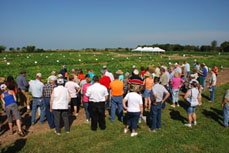 Here is a preview of the topics on the agenda for this year's program:
Here is a preview of the topics on the agenda for this year's program:
- Pumpkin Variety Selection
- Ornamental Corn Variety Trial
- Disease Management in Pumpkin Production
- Weed Management in Pumpkin Production
- Insect Management in Pumpkin Production
- Tips for Making the Most of Your Crop Protection Sprays
- New Ideas in Pumpkin Marketing from Ohio
Also, there will be opportunities to visit with industry vendors and of course share experiences with other local growers. We hope to see you there!
Nathan Johanning (618-939-3434; njohann@illinois.edu)
Vegetable Production and Pest Management
Update on Downy Mildew and Other Cucurbit Diseases in Illinois in 2016
In the past six weeks, the following diseases have been observed in cucurbits: (1) downy mildew, caused by Pseudoperonospora cubensis; (2) anthracnose, caused by Colletotrichum orbiculare; (3) angular leaf spot, caused by Pseudomonas syringae pv. lachrymans; (4) bacterial spot, caused by Xanthomonas cucurbitae; (5) powdery mildew, caused by Podosphaera xanthii; and (6) Phytophthora blight, caused by Phytophthora capsici. For the updates on management of these diseases, refer to the Midwest Vegetable Production Guide for Commercial Growers 2016 (https://ag.purdue.edu/btny/midwest-vegetable-guide/Pages/default.aspx).
Downy mildew was diagnosed in a processing pumpkin field in Tazewell County on August 10, 2016. Downy mildew is a devastating disease on cucurbits. After the heavy rainfalls of the past 3 days, pathogen of the downy mildew disease may rapidly spread and infect cucurbit crops. This strain will likely infect all cucurbit crops. Downy mildew only affects leaves. Symptoms of downy mildew vary with the host and the environmental conditions. The first symptom is usually the appearance of indistinct, pale green areas on the upper leaf surface. The pale green areas soon become yellow in color and angular to irregular in shape, bounded by the leaf veins. As the disease progresses the lesions may remain yellow or become brown and necrotic. During moist weather the corresponding lower leaf surface is covered with a downy, pale gray to purple mildew. There are several fungicides effective against downy mildew, which are: Revus (mandipropamid), Orondis Opti (oxathiapiprolin + chlorothalonil), Ranman (cyazofamid), Omega (fluazinam), Zampro (ametoctradin + dimethomorph), Gavel (mancozeb + zoxamide), Previcur Flex (propamocarb), and Zing (zoxamide + chlorothalonil). In our field trial in 2015, Revus, Ranman, Omega, and Orondis controlled downy mildew of pumpkin effectively. Any of these compounds should be mixed with chlorothalonil (e.g., Bravo Weather Stik), if not already pre-mixed, and alternated with another compound with a different mode of action (different FRAC code) and applied at weekly intervals.
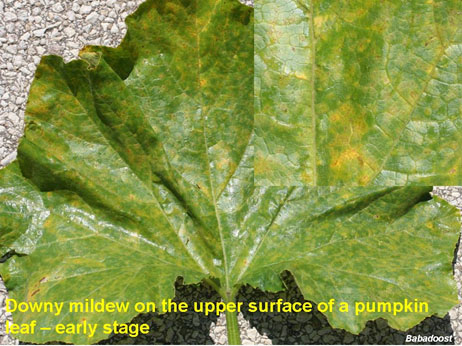
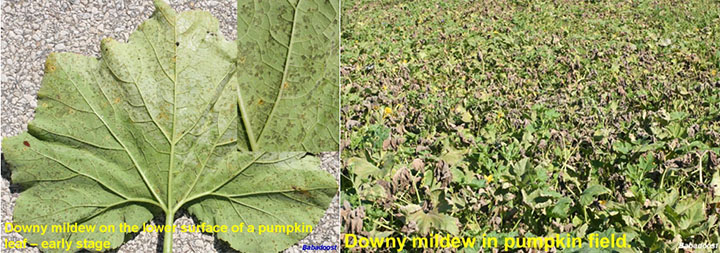
Anthracnose was observed in cucumber and muskmelon in various locations in Illinois in the past four weeks. Only leaves were affected. Symptoms included circular, light brown to reddish, from 0.2- to 0.5-inch in diameter. Some of the lesions cracked and dropped out, creating a shot-hole appearance. Several fungicides effectively control anthracnose of cucurbit diseases. Applications of Quadris (azoxystrobin) alternated with Bravo (chlorothalonil) are effective for managing anthracnose of cucurbits in Illinois.

Angular leaf spot, a bacterial disease, was observed in July and August in many cucumber production locations. The disease was observed on leaves only. Symptoms appeared as small, water-soaked lesions on leaves. The lesions were yellow in the beginning, but they become dry, turn tan brown, and some dropped out. We tested some copper compounds for their efficacy on control of angular leaf spot of cucumber. Tested copper compounds delayed disease development for about 2 weeks, but failed to protect plants against the disease for full season. Planting resistant/tolerant cultivars, crop rotation with noncucurbit crops for at least 2 years, using drip irrigation rather than overhead irrigation, avoiding working in the field when the foliage is wet, and application of copper are recommended practices for managing angular leaf spot.
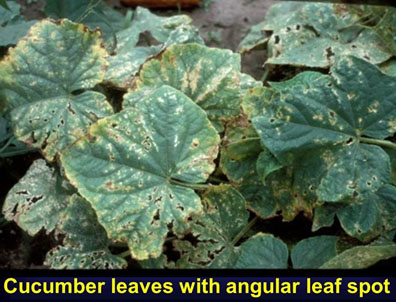
Bacterial spot is an emerging disease of cucurbits in Illinois and other Midwestern states. This disease affects only pumpkins (both jack-o-lantern and processing pumpkins) and all winter squash cultivars; the disease has not been observed on other cucurbits in Illinois in the past 10 years. Bacterial spot was observed in most of pumpkin and winter squash fields in Illinois in August. X. cucurbitae infects both leaves and fruits. Symptoms on leaves are small (1-2 millimeters) and dark lesions, with indefinite yellow margin. Some lesions coalesce and formed larger necrotic areas. On fruits, initial lesions are small, slightly sunken, circular spots, 1/16 to 1/4 inch in diameter, with a beige center and a dark- brown halo. Later the cuticle and epidermis may crack. On mature fruits, saprophytic fungi and bacteria may colonize the dead, tan tissue at the center of the lesion, resulting in collapse and decay of the fruit. Managing this disease is a challenging task. Best practices for minimizing the losses to the bacterial spot at this time of the season are keeping fruits (even fruits with lesions) as dry as possible and spray-applications of effective compounds. The data from our field trials in the past 5 years showed that applications of copper compounds (e.g., Kocide-3000) mixed with mancozeb (e.g., Dithane), Tanos (cymoxanil + famoxadone), or Quintec (quinoxyfen) reduced incidence and severity of bacterial spot on fruits.
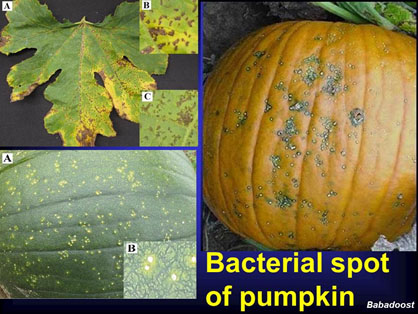
Powdery mildew was observed in pumpkin and squash (summer and winter squash cultivars) in August in most of the fields visited. The disease developed later in 2016 than in the past and severity of the disease is low. Powdery mildew is diagnosed by white, powdery mold on plant tissues. Powdery fungal growth develops on both leaf surfaces, petioles, and stems. The disease first appears on lower stems and petioles. As the disease continues to develop, the white, moldy spots occur on the underside of leaves, then on the upper leaf surfaces. Yellow spots may form on upper leaf surfaces opposite to powdery mildew colonies on the underside of leaves. Infected leaves usually weather and die. There are several effective fungicides available for control of powdery mildew of cucurbits. The following fungicides are effective against powdery mildew of cucurbits in Illinois: Quintec (quinoxyfen), Procure (triflumizole), Rally (myclobutanil), Fontelis (penthiopyrad), Microthiol (sulfur), Torino (cyflufenamid), and Pristine (pyraclostrobin + boscalid).
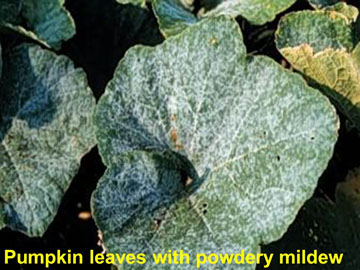
Phytophthora blight was observed in jack-o-lantern pumpkin, processing pumpkin, yellow squash, zucchini, butternut squash, cantaloupe, and watermelon in central Illinois in July and August. The infection was observed on vines (mainly pumpkins) and fruit. Water-soaked lesions developed on vines. Fruit rot occurred on all developing stages of fruits. For management of Phytophthora blight during the remainder of the season, keep soil moisture as low as possible, do not irrigate from ponds that fill from run-off through soils infested with P. capsici, and spray crops with effective fungicides. Based on the data from the field trials in past years, Revus (mandipropamid), Ranman (cyazofamid), Tanos (cymoxanil + famoxadone), and Orondis (oxathiapiprolin) are more for managing Phytophthora blight in cucurbit production.
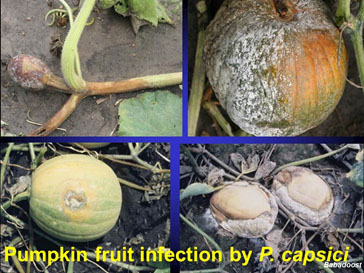
Mohammad Babadoost (217-333-1523; babadoos@illinois.edu)
Late-Season Weed Management
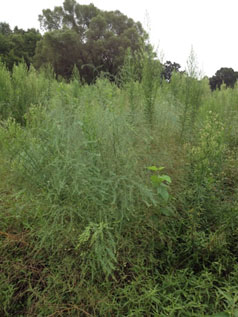
The escaped marestail in this
asparagus field is getting ready to
flower and go to seed. Any
efforts to help manage this weed
and prevent it from going to
seed will help to reduce the
amount of marestail pressure in
this field in future seasons.
Photo: N. Johanning
Now that we have reached the peak of the growing season, much of our focus shifts to harvest and disease and insect management. Often times late in the season, weed management takes a back seat to some of the other activities on the farm. While for some crops late season weed management may not make drastic changes in this season's crop, it can have implications for the future. Any weeds that go to seed will only increase the "bank" of weed seeds in your field which will lead to more weed pressure from that weed species in the future. Over the course of multiple years of weeds going to seed, you can end up with many more weeds to battle than before. Now I realize that we will usually not have the resource, either chemical or manual labor, to remove all weeds, but every little bit can help. Here are a few ideas for some things that can be done to help manage weeds.
Remove weeds from areas once harvest is done. If you are done with a given sweet corn, cucumber, etc. plot do not just let it grow up in weeds. Mow it, spray it, till it or do something. Even just mowing it down will significantly reduce the amount of seed produced. While you are at it, maybe you want to put a cover crop in it to help keep the weeds down.
Crop Rotation. Your rotation might be set for this year, but it might be a good time to consider the weeds now and what you want to plant in the future. Anytime we continuously grow the same or similar crops in the same area year after year (and have the same weed species that escape and go to seed) we are going to build up a population of our most persistent and problematic weeds. Even if we do not use any herbicides, some crops by their season, maturity, and growth habit are more competitive with certain weeds than others. If herbicides are utilized, consider including crops such as sweet corn or others with more herbicide options into the rotation to help "clean up" for at least one year of the rotation.
Don't forget to pull and hoe. Hand weeding is not on the top of anyone's list, but sometimes even just an hour with a good sharp hoe or weed hook can make a lot of difference. I already have that down as a part of my weekend plans in my pumpkins.
Remember the overall goal is just to reduce the number of weeds going to seed in your field. Often a little time invested now can pay greatly in future seasons!
Nathan Johanning (618-939-3434; njohann@illinois.edu)
Less Seriously ...
As we get geared up for pumpkin field day and the fall season, thought a few of these would be appropriate.
Q: How do you fix a broken pumpkin?
A: With a pumpkin patch
Q: Why was the jack-o-lantern afraid to cross the road?
A: It had no guts!
Q: What do you use to mend a jack-o-lantern?
A: A pumpkin patch.
Q: Why did the pumpkin cross the road?
A: It fell off the wagon!
--www.jokes4us.com
University of Illinois Extension Specialists in Fruit and Vegetable Production & Pest Management
Extension Educators – Local Food Systems and Small Farms |
||
Bronwyn Aly, Gallatin, Hamilton, Hardin, Pope, Saline, and White counties |
618-382-2662 |
|
Katie Bell, Franklin, Jackson, Perry, Randolph, & Williamson counties |
618-687-1727 |
|
Sarah Farley, Lake & McHenry counties |
847-223-8627 |
|
Nick Frillman, Woodford, Livingston, & McLean counties |
309-663-8306 |
|
Laurie George, Bond, Clinton, Jefferson, Marion, & Washington counties |
618-548-1446 |
|
Zachary Grant, Cook County | 708-679-6889 | |
Doug Gucker, DeWitt, Macon, and Piatt counties |
217-877-6042 |
|
Erin Harper, Champaign, Ford, Iroquois, and Vermillion counties |
217-333-7672 |
|
Grace Margherio, Jackie Joyner-Kersee Center, St. Clair County |
217-244-3547 |
|
Grant McCarty, Jo Daviess, Stephenson, and Winnebago counties |
815-235-4125 |
|
Katie Parker, Adams, Brown, Hancock, Pike and Schuyler counties |
217-223-8380 |
|
Kathryn Pereira, Cook County |
773-233-2900 |
|
James Theuri, Grundy, Kankakee, and Will counties |
815-933-8337 |
|
Extension Educators – Horticulture |
||
Chris Enroth, Henderson, Knox, McDonough, and Warren counties |
309-837-3939 |
|
Richard Hentschel, DuPage, Kane, and Kendall counties |
630-584-6166 |
|
Andrew Holsinger, Christian, Jersey, Macoupin, & Montgomery counties |
217-532-3941 |
|
Extension Educators - Commercial Agriculture |
||
Elizabeth Wahle, Fruit & Vegetable Production |
618-344-4230 |
|
Nathan Johanning, Madison, Monroe & St. Clair counties |
618-939-3434 |
|
Campus-based Extension Specialists |
||
Kacie Athey, Entomology |
217-244-9916 |
|
Mohammad Babadoost, Plant Pathology |
217-333-1523 |
|